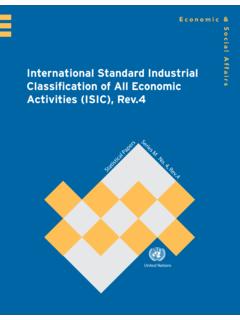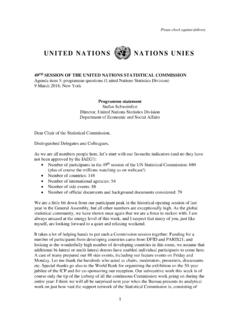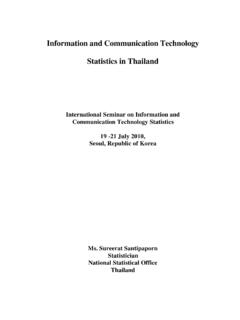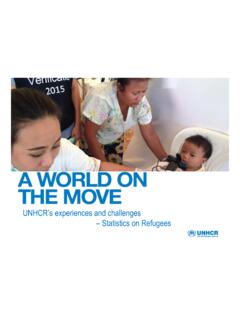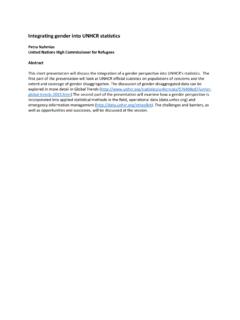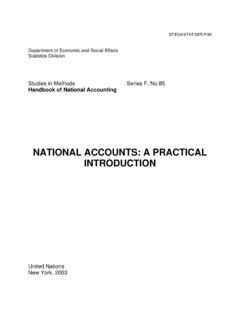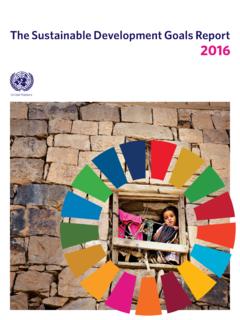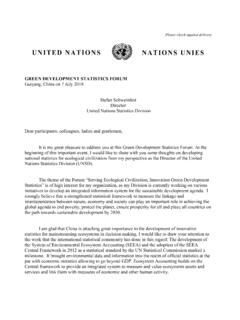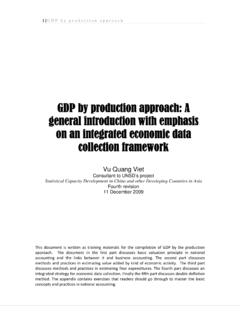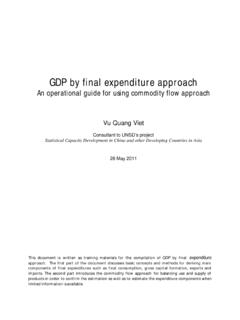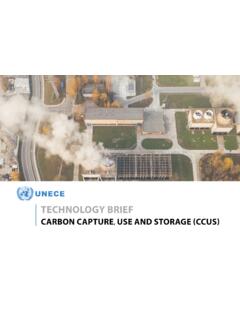Transcription of How COVID-19 is changing the world: a statistical ...
1 How covid -19is changing the world: a statistical perspective Volume II 2020 Committee for the Coordination of statistical Activities. Some rights publication is copyrighted under the Creative Commons Attribution IGO designations employed and the presentation of material on any map in this work do not imply the expression of any opinion whatsoever on the part of the United Nations or other contributing organizations concerning the legal status of any country, territory, city or area or of its authorities, or concerning the delimitation of its frontiers or boundaries. Dotted and dashed lines on maps represent approximate border lines for which there may not yet be full publication has not been formally Population Division of the United Nations Department of Economic and Social Affairs (UN DESA) provided desktop publishing, with modifications on covers prepared by organisationsAsian Development Bank (ADB)African Development Bank (AfDB)Bank for International Settlements (BIS)Cooperation Council for the Arab Countries of the Gulf (GCC)European Central Bank (ECB)EurostatFood and Agriculture Organization of the United Nations (FAO)
2 International Civil Aviation Organization (ICAO)International Labour Organization (ILO)Office of the United Nations High Commissioner for Human Rights (OHCHR)Organisation for Economic Co-operation and Development (OECD)Partnership in Statistics for Development in the 21st Century (PARIS21)United Nations Children s Fund (UNICEF)United Nations Conference on Trade and Development (UNCTAD)United Nations Development Programme (UNDP)United Nations Economic and Social Commission for Asia and the Pacific (UN ESCAP)United Nations Economic and Social Commission for West Asia (ESCWA)United Nations Economic Commission for Africa (UNECA)United Nations Economic Commission for Latin America and the Caribbean (ECLAC)United Nations Educational, Scientific and Cultural Organization (UNESCO)United Nations Entity for Gender Equality and the Empowerment of Women (UN Women)United Nations High Commissioner for Refugees (UNHCR)United Nations Human Settlement Programme (UN Habitat)United Nations Industrial Development Organization (UNIDO)United Nations Office on Drugs and Crime (UNODC)United Nations Department of Economic and Social Affairs, Population Division (UN DESA/PD)
3 United Nations Department of Economic and Social Affairs, Statistics Division (UN DESA/SD) United Nations World Tourism Organization (UNWTO) Universal Postal Union (UPU)World Bank (WB)World Trade Organization (WTO) 2 The Committee for the Coordination of statistical Activities (CCSA)The CCSA is comprised of international and supranational organizations whose mandates include the provision of international official statistics guided by the Principles Governing International statistical Activities ( ) and which have a permanent embedded statistical service that maintains regular contact with countries. The mandate of the CCSA is to ensure the efficient functioning of the international statistical system, to assist Governments in the development of common statistical standards, platforms and methodologies, and to provide inter-institutional support, outreach and advocacy for high-quality official information can be found on the CCSA webpage: are pleased to present the second volume of How COVID-19 is changing the world: a statistical perspective.
4 Since the release of the first volume in May 2020, the COVID-19 pandemic has continued to rage around the world. By the end of August, countries around the globe had reported over 25 million cases, with nearly 850,000 deaths attributed to the disease. The pandemic presents tough choices. National and regional governments, local communities, health and school systems, as well as families and businesses are being forced to take many difficult decisions: How to re open safely? How to safeguard people s lives and protect their livelihoods? Where to allocate scarce resources? How to protect those unable to protect themselves?
5 Answers to questions like these will affect our short-term success in battling the virus and could have impacts for generations to come. More than ever, the world needs reliable and trustworthy data and statistics to inform these important decisions. The United Nations and all member organizations of the Committee for the Coordination of statistical Activities (CCSA) collect and make available a wealth of information for assessing the multifaceted impacts of the pandemic. This report updates some of the global and regional trends presented in the first volume and offers a snapshot of how COVID-19 continues to affect the world today across multiple domains.
6 The report also highlights the impact of the pandemic on specific regions and population groups. The information contained herein is even grimmer than in the first volume, confirming the unprecedented impact of the pandemic on the economic and social fabric of our societies. Some key findings are as follows: Trends in COVID-19 caseloads differ widely by country, illustrating the unpredictable nature of the pandemic and theimportance of remaining vigilant in our battle against the virus; Global foreign direct investment is now projected to fall by as much as 40 percent in 2020; Global manufacturing output fell by 20 per cent in April 2020 compared to the same period of the previous year, acceleratingan already declining trend; The pandemic is pushing an additional 71 to 100 million people into extreme poverty.
7 Globally, the first quarter of 2020 saw a loss of the equivalent to 155 million full-time jobs, a number that increased to 400million in the second quarter, with lower- and middle-income countries hardest hit; Simulations suggest a steep and unprecedented decline in the Human Development Index (HDI), undermining six years ofprogress; As recipients of 43 per cent of global remittance inflows, the developing economies of Asia and the Pacific are especiallyvulnerable to the global economic stall and its impact on the transfer of remittances by migrant workers; To mitigate the impact of the pandemic in Africa, the African Development Bank has invested USD billion to establish aCrisis Response Facility; Data from 31 countries over the period 2014 to 2019 show that about 1 in 5 people reported having experienceddiscrimination on at least one of the grounds prohibited by international human rights law, highlighting the need for covid -19responses to ensure that the pandemic does not exacerbate existing forms of discrimination; Even before the pandemic, women did three times more unpaid domestic and care work than men.
8 Since the pandemic,however, data from rapid gender assessment surveys indicate that women in some regions are shouldering the extra burdenof an increased workload, particularly in terms of childcare and household report also provides a glimpse of the challenges faced by national statistical systems. At a time when reliable information is more essential than ever, many systems are struggling to compile basic statistics, due in part to the pandemic but also because of a lack of resources needed to modernize operations and data and statistics presented in this report are but the tip of an iceberg. Readers are encouraged to visit the websites of the contributing organizations, where they can find additional information on the impact of COVID-19 and other topics.
9 Lastly, we would like to give special thanks to the CCSA secretariat (Statistics Division of UN DESA) and to the teams at UNICEF and in the Population Division of UN DESA, led by Mark Hereward and John Wilmoth, respectively, which joined forces to edit this collection of statistical information about the pandemic. Without their commitment and dedication, this report would not have been possible. Angela MeChief, Research and Trend Analysis BranchUNODCCo-chair CCSA#StatisticalCoordinationHaishan FuDirector, Development Data GroupWorld BankCo-chair CCSA4 Table ofContents5 ECONOMIC IMPACT 10 SOCIAL IMPACT 34 REGIONAL IMPACT 48 statistical IMPACT 62 COVID-19 6 Differential success in mitigating the pandemic (UN DESA/PD).
10 8 Global banking up in the initial phase of COVID-19 (BIS) .. 12 Need for high-quality data on a timely basis (ECB) ..14 Aviation standstill with slow and shallow recovery (ICAO).. 16 Working hours drop significantly (ILO) ..18 Small, medium and vulnerable (OECD) ..20 Many more children likely in monetary poor households (UNICEF) .. 22 Dramatic drop in foreign direct investment (UNCTAD) ..24 Slow recovery after production slump (UNIDO) ..26 Disruption of the international postal supply chain (UPU) ..28 About 71 to 100 million people pushed into extreme poverty (WB) ..30 Restrictions in exports (WTO).
